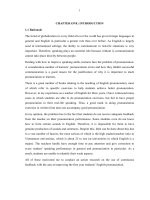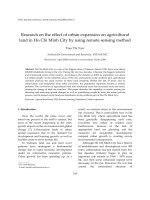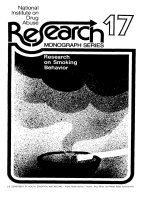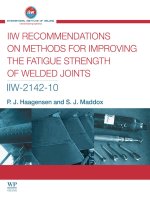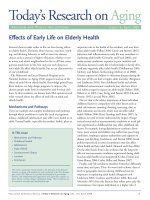research on fatigue behavior of welded joint spraying fused by low transformation temperature alloy powder
Bạn đang xem bản rút gọn của tài liệu. Xem và tải ngay bản đầy đủ của tài liệu tại đây (2.26 MB, 7 trang )
Research on fatigue behavior of welded joint spraying fused by low
transformation temperature alloy powder
Xiaohui Zhao
a,
⇑
, Dongpo Wang
b
, Caiyan Deng
b
a
Key Laboratory of Automobile Materials, School of Materials Science and Engineering, Jilin University, Changchun 130025, China
b
School of Materials Science and Engineering, Tianjin University, Tianjin 300072, China
article info
Article history:
Received 16 May 2013
Accepted 9 July 2013
Available online 29 July 2013
Keywords:
D. Welded joint
C. Modification of spraying fused
E. Fatigue strength
abstract
Modification of spraying fused (MSF) of plasma arc as heat source was used to improve the fatigue per-
formance of welded joint, which both fundamentally reduced stress concentration at weld toe and
achieved metallurgical bond between spraying fused coating and welding. The low transformation tem-
perature alloy powder was applied to the method of MSF. After spraying fusion, especially spraying fused
joint by low transformation temperature alloy powder, the distribution of residual stress is more difficult
to be obtained. Finite element (FE) simulation as an important tool was used to determine the stress field
and temperature field of spraying fused joint. Simulated results show that as-welded joint and welded
joint spraying fused by conventional nickel base alloy powder (Conventional-joint) present tensile stress.
The stress of welded joint spraying fused by low transformation temperature alloy powder (LTT-joint) is
compressive stress. Fatigue test results indicated that under the condition of 2 Â 10
6
cycles, the fatigue
strength of as-welded joint is 135 MPa, while that of Conventional-joint and LTT-joint is 218 MPa and
235 MPa, respectively. The fatigue strength of Conventional-joint increases by 61.48%, and fatigue
strength of LTT-joint increases by 74.07%.
Crown Copyright Ó 2013 Published by Elsevier Ltd. All rights reserved.
1. Introduction
Welded joints are widely used in the engineering structure.
Most of welded joints work under the condition of cyclic loading.
Therefore, fatigue failure is one of the most common and danger-
ous failure ways [1]. There exists serious structural stress concen-
tration and a certain number of welding defects at weld toe.
Welding defects is equal to the natural fatigue crack source, greatly
reducing the time of crack initiation. So as to the fatigue life is
mainly decided by the crack propagation. Consequently, it is very
meaningful to take technologic treatment to reduce the stress con-
centration and eliminate defects for the improvement of fatigue
strength [2–5].
The existing technique of prolonging mainly consists of TIG-
dressing [6,7], welding toe grinding and ultrasonic peening treat-
ment (UPT) [8–11]. TIG-dressing and welding toe grinding are
important industrial techniques, but they are faced with the risk
of reducing the strength of welded joint due to the change of
cross-sectional area. UPT [12–17] mainly rely on the presence of
compressive residual stresses to improve fatigue lives of welded
joint. Tensile residual stresses in welding area weaken the tensile
load capacity. As a result, the fatigue life is shortened. For that
reason we attempt to reduce or at least eliminate these harmful
stresses. By means of periodic impacts or peens with frequencies
above 20 kHz, UPT creates a deformation in tensile zone on the sur-
face of weld and/or weld toe. Tensile stresses can be relieved by
this action. Moreover, cracks and voids are closed, and weld toe
geometry is modified. Compressive residual stress is induced by
the regional plastic deformation as well. However, UPT also has
some shortcomings. For example, the residual compressive stress
will be released with the increase of stress level. Thus, UPT will
be hard to maintain its ability to resist fatigue. In general, UPT
are not suitable for structures operating at applied stress ratios
R > 0.5 or maximum applied stresses above around 80% yield.
In this study, modification of spraying fused (MSF) as a new
method to improve the fatigue strength of cruciform welded joint
was proposed. Deng et al. also studied this new technique [18].
MSF fundamentally reduces stress concentration at weld toe.
Meanwhile, metallurgical bond between spraying fused coating
and weld can make welded joint bear much larger plus alternating
load. In this paper, the heat source of MSF is a plasma flame, which
has excellent performance. In addition, the low transformation
temperature alloy powder was applied to the method of MSF,
which will make the spraying fused coating form compressive
residual stress. Such, the MSF with low transformation tempera-
ture alloy powder both reduce the stress concentration and form
the residual compression stress, which will further improve the fa-
tigue performance of welded joint.
0261-3069/$ - see front matter Crown Copyright Ó 2013 Published by Elsevier Ltd. All rights reserved.
/>⇑
Corresponding author. Tel./fax: +86 0431 85094687.
E-mail address: (X. Zhao).
Materials and Design 53 (2014) 490–496
Contents lists available at ScienceDirect
Materials and Design
journal homepage: www.elsevier.com/locate/matdes
2. Experiments
2.1. Testing specimens and method
The basic principle of MSF (see Fig. 1) is to spray fusing a met-
allurgical bonding layer of high curvature appearance on the sur-
face of the whole welded joint, which can greatly reduce the
stress concentration of welded joint [18]. In order to reduce defects
and enhance the bonding strength, this paper use plasma flame in-
stead of oxygen acetylene flame to MSF.
Specimens were cruciform welded joints (carbon-dioxide arc
welding with substrate material of low-carbon steel Q235B and
welding material of H08Mn2Si), whose geometrical characteristics
are shown in Fig. 2. Table 1 is mechanical properties of Q235B
steel. Spraying fused materials was nickel-base alloy powder
(Ni65Cr16B3.1Si4.5), also including low transformation tempera-
ture alloy powder. They have good oxidation resistance, impact
toughness, corrosion and heat resistance.
2.2. The choice of low transformation temperature alloy powder
According to actual circumstances, the author assumes that:
800 °C is a plastic transition point, there is no thermal contraction
stress under the condition of this temperature. The relationship
between M
s
and stress under the constraint condition is analyzed.
Fig. 1. Basic principle of MSF.
Fig. 2. Geometric dimensioning of as-welded joint.
Table 1
Mechanical properties of Q235B steel.
Material Yield
strength
r
s
(MPa)
Tensile
strength
r
b
(MPa)
Elongation
(d)
Elasticity
modulus E
(GPa)
Poisson’s
ratio (
m
)
Q235B 267.4 435.5 26% 206 0.3
Fig. 3. Development of stress during constrained cooling.
Fig. 4. Finite element model of as-welded joint.
Fig. 5. Finite element model of spraying fused joint.
X. Zhao et al. /Materials and Design 53 (2014) 490–496
491
Literature [19] shows that different combinations of Ni and Cr will
be of different linear expansion coefficient and strain, etc.
Tensile stress (
r
tensile
) is formed due to volume shrinkage of
material during the cooling process since temperature decreases
from 800 °C. Phase transformation stress (
r
compressive
) generated
due to volume expansion caused by martensite phase transforma-
tion when the temperature drops to phase transition point (M
s
).
The interaction of phase transformation stress (
r
compressive
) and
previous tensile stress form the final residual stress (
r
):
r
¼
r
tensile
þ
r
compressive
ð1Þ
r
tensile
¼ E Á
De
l
ð2Þ
r
compressive
¼ E Á
De
p
ð3Þ
where E is the average elastic modulus;
D
e
l
is strain shrinkage
caused by heat bilges cold shrink of material;
D
e
p
is expansion
strain caused by martensite phase transformation.
From formula (1)–(3), Stress–Temperature curves of five kinds
of low transformation temperature alloy powder can be gained
(see Fig. 3).
Fig. 3 shows that the largest residual compressive stress was
obtained at room temperature when M
s
is about 200 °C. Based on
the above analysis, the phase transition point of alloy powder
should be controlled at around 200 °C. The chemical composition
of alloy system (wt%) is: C < 0.12, Cr = 5–8, Ni = 8, Mn = 1.0,
Si = 0.8, Mo = 0.5, Ti = 0.07, Cu = 0.3, S = 0.005, P = 0.005, B = 0.8,
also including a moderate amount of rare earth elements, allow-
ance for Fe.
2.3. Method and parameters of MSF
In this paper, plasma flame is used to modification processing.
Before spraying, the surface of welded joint was pre-grinded,
which not only eliminates oxide in the surface of welded joint,
but also maintains certain roughness of the surface, thus improv-
ing the adhesion strength between coating and welding. The pro-
cess of modification of plasma spurt spraying only need to
change horizontal swing of spray jet into circular orbit rotation
on the basis of spraying process, which can be completed by robot
of controlling nozzle line. The basic parameters for this test is:
turning radius of spray jet of 200 mm; swing Angle of about 5°;
oscillation frequency of 1 times/s. The feeding switch is off after
forming overall shape, the non-transferred arc of plasma arc is
used to adjust edge position of spray welding layer at a small scale.
Meanwhile, for different alloy powder, the process parameters can
be appropriate adjusted.
2.4. The temperature field and stress field of spraying fused joint
The residual stress of cruciform welded joint is difficult to be
measured accurately by the traditional measuring method because
of its complicated structure. After spraying fusion, especially
spraying fused joint by low transformation temperature alloy pow-
der, the distribution of residual stress is more difficult to be ob-
tained. Finite element (FE) simulation has become an important
tool for the prediction of residual stresses of welded joint. 3D FE
modeling of a single pass cruciform welded joint and spraying
fused joint are set up by ANSYS. According to geometric dimen-
sioning of as-welded joint (see Fig. 2), the modeling of as-welded
joint is showed in Fig. 4. According to geometric dimensioning of
spraying fused coating, the modeling of spraying fused joint is
showed in Fig. 5. Fig. 5 shows that the minimum thickness of coat-
ing is 0.5 mm, and knuckle radius (
q
)is20mm.
The method of coupled thermal stress analysis is adopted.
Firstly a transient thermal analysis is finished to predict the tem-
perature filed of the whole joint and spraying fused coating. Then
the results of the thermal analysis are applied as a thermal body
load in a transient structural analysis to calculate stresses. In this
process, the technique of ‘element birth and death’ is used for mod-
eling of the welding and coating material. Heat source is applied in
the form of heat flux density.
Heat flux density is calculated according to the actual parame-
ters of spraying fused coating and welding. The total quantity of
heat source can be obtained through the current (I), voltage (U)
and thermal efficiency (
g
). The total quantity divided by the total
volume is per unit volume of heat, and Heat flux density (q)is
calculated according to the formula of Q
v
= q
Ã
t(q), t is the time
corresponding to a loading step during the process of simulation.
The size of heat flux density is q = 7.90 Â 10
10
w/m
3
s in this
simulation.
Table 2
Hardness and Young’s modulus of Conventional-joint at three different positions.
Conventional-joint Coating Transition zone Welding
Hardness H (GPa) 6.417 3.829 1.944
Young’s modulus E (GPa) 225.221 182.55 196.209
Fig. 7. Temperature field of spraying fused coating.
Fig. 6. The bonding condition of Conventional-joint between coating and welding.
492 X. Zhao et al. /Materials and Design 53 (2014) 490–496
3. Fatigue test
Specimens were divided into three groups: as-welded joint,
welded joint spraying fused by conventional nickel base alloy
powder (Conventional-joint) and welded joint spraying fused by
low transformation temperature alloy powder (LTT-joint).
All fatigue tests were carried out under constant amplitude
load, in term of stretch bending combined loads, with stress ratio
(R) of 0.1. Tests were carried out on 100 kN HF Fatigue Testing
Machine, whose static load error for full measuring range is
±0.2%. Besides, error of the dynamic load is ±2%.
4. Results and discussion
4.1. The mechanical property of spraying fused joint
The purpose of MSF is to improve fatigue strength of welded
joint. The adhesion strength between coating and welding which
greatly affects the fatigue strength is very important. Fig. 6 showed
the bonding condition between coating and welding of Conven-
tional-joint. From Fig. 6 we can see that coating and welding
achieved perfectly metallurgy bonding. There is no impurities
and air hole exit. Therefore, it is difficult for fatigue crack source
to form at the transition zone.
Fig. 8. The cooling process of spraying fused coating.
Fig. 9. The extraction path of residual stress.
X. Zhao et al. /Materials and Design 53 (2014) 490–496
493
The Hardness and Young’s modulus of Conventional-joint at
three different positions (coating, transition zone and welding)
based on nano-indentation were shown in Table 2. From Table 2,
the value of Hardness and Young’s modulus gradually increases
from welding to coating.
In addition, the Hardness and Young’s modulus of LTT-joint are
basic the same with Conventional-joint.
4.2. Simulated results
Because of the distribution of residual stress is decided by tem-
perature profile, we first study the distribution of temperature
field. Stress field of LTT-joint is simulated by changing the linear
expansion coefficient of Conventional-joint, therefore, Conven-
tional-joint and LTT-joint share a temperature field.
Fig. 7 is temperature profile of spraying fused coating at some
time. In the process of simulation, cooling process of temperature
field is very important. The sample finally is used at room temper-
ature, so the temperature of the spray welding layer should be
reduced to room temperature. Fig. 8 is cooling process of spraying
fused coating. Fig. 8a shows that the distribution of isotherm is
uniform during the cooling process of spraying fused coating. The
larger temperature gradient does not exist at each location.
Fig. 8b is the final cooling effect, and the whole temperature of
spraying fused coating is around 22 °C, basically achieving the de-
sired cooling effect.
Residual tensile stress of welded joint will reduce fatigue
strength of joint. Thus, the distribution of residual stress of spray-
ing fused joint is very important. The extraction path of residual
stress was shown in Fig. 9. Because the loading direction of fatigue
specimen is the direction of X axis, we only analyzed stress distri-
bution of direction of X axis. Fig. 10 is stress cloud chart of as-
welded joint. Fig. 11 is stress cloud chart of welded joint spraying
fused by conventional nickel base alloy powder (Conventional-
joint). Fig. 12 is stress cloud chart of welded joint spraying fused
by low transformation temperature alloy powder (LTT-joint).
Fig. 13 is stress distribution of X-direction of As-welded joint, Con-
ventional-joint and LTT-joint along path P1 in the same coordinate
system, and Fig. 14 is Stress distribution of X-direction of three
kinds of joints along path P2 in the same coordinate system.
From Fig. 13 we can see that as-welded joints present large ten-
sile stress in this direction. Maximum value of tensile stress
reached 294 MPa. The stress of Conventional-joint is also tensile
stress at weld toe. But compared to as-welded joint, the value of
tensile stress is smaller, only is 107 MPa. The stress of LTT-joint
is compressive stress at weld toe of coating, and the maximum
value of compressive stress reached À126 MPa. The residual com-
pressive stress in the direction of fatigue loading will significantly
increase the fatigue life of welded joint. From Fig. 14 we can see
that as-welded joint and Conventional-joint present tensile stress
Fig. 10. Stress cloud chart of as-welded joint.
Fig. 11. Stress cloud chart of Conventional-joint.
Fig. 12. Stress cloud chart of LTT-joint.
Fig. 13. Stress distribution of X-direction of three kinds of joints along path P1.
494 X. Zhao et al. /Materials and Design 53 (2014) 490–496
of 300 MPa in this direction. The stress of LTT-joint is compressive
stress.
Therefore, the fatigue crack sources of as-welded joint and most
of Conventional-joints formed at weld toe for residual tensile
stress. However, fatigue crack source of LTT-joint has been
transferred to the base metal for residual compressive stress.
4.3. S–N curve
In order to further verify the accuracy of simulation results and
residual compressive stress effects on fatigue life of welded joint,
high cycle fatigue tests were done. For high cycle fatigue, the max-
imum stress is always lower than yield strength of material. When
stress ratio is 0.1, stress range is also certain lower than yield
strength. Fatigue life corresponding to different stress range can
be gained by fatigue tests. S–N curves (The authorized surviving
fraction is 50%) of welded joints (as-welded joint, Conventional-
joint, LTT-joint) are shown in Fig. 15. Fatigue strength of three kinds
of joint corresponding to 2 Â 10
6
cycles were shown in Table 3.
Through calculation, it is clear that under the condition of
2 Â 10
6
cycles, the fatigue strength of as-welded joint is 135 MPa,
while that of Conventional-joint and LTT-joint is 218 MPa and
235 MPa, respectively. The fatigue strength of Conventional-joint
increases by 61.48%, and fatigue strength of LTT-joint increases
by 74.07%.
4.4. Fracture analysis
For as-welded joint, the fatigue crack sources of fractured spec-
imens are all at weld toe. For welded joint with the spray coating
(Conventional-joint, LTT-joint), the locations of fatigue crack
source of fractured specimens are shown in Fig. 16. From Fig. 16
we can see that, most of crack sources of Conventional-joints ap-
pear in the weld toe between spray coating and base metal (see
Fig. 16a), and most of crack sources of LTT-joints appear in the base
metal (see Fig. 16b). Meanwhile, there is also a small part of
Conventional-joint fractured in the base metal and a small part
of LTT-joint fractured in the weld toe between spray coating and
base metal.
5. Conclusions
Modification of spraying fused (MSF) of plasma arc as heat
source both fundamentally reduced stress concentration at weld
toe and achieved metallurgical bond between spraying fused coat-
ing and welding. This method also can form compressive residual
stress on the surface of welded joint by means of alloy powder
with low phase transition point, which will significantly improve
the fatigue performance of welded joint. The application of numer-
ical simulation method plays an important role for understanding
mechanism and characteristics of MSF. Fatigue testing results
showed that under the condition of 2 Â 10
6
cycles, the fatigue
Table 3
Fatigue strength of three kinds of joints (R = 0.1).
Type of joint Fatigue strength
(2 Â 10
6
)
D
r
(MPa)
Slope (m) Increase
degree (%)
As-welded joint 135 6.23 –
Conventional-joint 218 9.88 61.48
LTT-joint 235 20.28 74.07
Fig. 16. The locations of fatigue crack source.
Fig. 15. S–N curves of three kinds of joints.
Fig. 14. Stress distribution of X-direction of three kinds of joints along path P2.
X. Zhao et al. /Materials and Design 53 (2014) 490–496
495
strength of as-welded joint is 135 MPa, while that of Conventional-
joint and LTT-joint is 218 MPa and 235 MPa, respectively. The fati-
gue strength of Conventional-joint increases by 61.48%, and fatigue
strength of LTT-joint increases by 74.07%.
In conclusion, modification of sprayingfused (MSF) of plasma arc
as heat source will have more widely practical value by adjusting
the different alloy powder. Study of MSF will play a promoting role
for the development of life-extending technology of welded joint.
Acknowledgements
This work was financially supported by the National Science
Foundation of Tianjin through Grant No. 50805102. The authors
wish to thank Professor D.P. Wang and associate professor C.Y.
Deng for their experimental supports.
References
[1] Lixing Huo. Fracture behavior and assessment of welded
structure. Beijing: China Machine Press; 2000
.
[2] Dahle T. Design fatigue strength of TIG-dressed welded joints in high-strength
steels subjected to spectrum loading. Int J Fatigue 1998;20(9):677–81
.
[3] Janosch JJ, Koneczny H, Debiez S, Statnikov ES, Tryufyakov VI, Mikheev PP.
Weld World 1996;37:72–83
.
[4] Statnikov ES, Muktepavel VO, Blomqvist A. Weld World 2002;46(3/4):20–32.
[5] Manteghi S, Maddox SJ. Methods for fatigue life improvement of welded joints
in medium and high strength steels. IIW Doc. XIII-2006-04; 2004.
[6] Ramalho Armando L, Ferreira José AM, Branco Carlos AGM. Fatigue behaviour
of T welded joints rehabilitated by tungsten inert gas and plasma dressing.
Mater Des 2011;32(10):4705–13
.
[7] Morisada Yoshiaki, Fujii Hidetoshi, Inagaki Fuminori. Development of high
frequency tungsten inert gas welding method. Mater Des 2012;44:12–6
.
[8] Yildirim Halid Can, Marquis Gary B. Fatigue strength improvement factors for
high strength steel welded joints treated by high frequency mechanical
impact. Int J Fatigue 2012;44:168–76
.
[9] Mori T, Shimanuki H, Tanaka M. Effect of UIT on fatigue strength of web-gusset
welded joints considering service condition of steel structures. Weld World
2012;56(9–10):141–9
.
[10] Abdullah Amir, Malaki Massoud, Eskandari Ahmad. Strength enhancement of
the welded structures by ultrasonic peening. Mater Des 2012;38:7–18
.
[11] Yang Xinjun, Zhou Jianxin, Ling Xiang. Study on plastic damage of AISI 304
stainless steel induced by ultrasonic impact treatment. Mater Des
2011;36:477–81
.
[12] Huther I, Lieurade HP, Souissi R, Nussbaumer A, Chabrolin B, Janosch JJ.
Analysis of results on improved welded joints. Weld World
1996;37(5):242–66
.
[13] Branco CM, Maddox SJ, Infante V, Gomes EC. Fatigue performance of TIG and
plasma welds in thin sections. Int J Fatigue 1999;22(6):589–602
.
[14] Kirkhope KJ, Bell R, Caron L, Basu RI, Ma K-T. Weld detail fatigue life
improvement techniques. Part 2: application to ship structures. Mar Struct
1999;12:477–96
.
[15] Kirkhope KJ, Bell R, Caron L, Basu RI, Ma K-T. Weld detail fatigue life
improvement techniques. Part 1: review. Mar Struct 1999;12:447–74
.
[16] Marquis G. Failure modes and fatigue strength of improved HSS welds. Eng
Fract Mech 2010;77(11):2051–62
.
[17] Roy S, Fisher JW, Yen BT. Fatigue resistance of welded details enhanced by
ultrasonic impact treatment (UIT). Int J Fatigue 2003;25:1239–47
.
[18] Zhao Xiaohui, Dongpo Wang, Deng Caiyan. J Mater Process Technol
2011;211:2039–44
.
[19] Wenxian Wang. Study on low transformation temperature welding electrode
and its application to improve fatigue performance of welded joints. PhD
thesis, Tianjin University, Tianjin; 2002.
496 X. Zhao et al. /Materials and Design 53 (2014) 490–496
